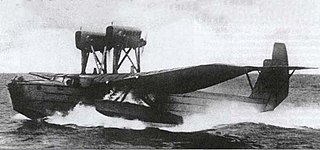Related Research Articles
Pre-revolutionary Imperial Russia did not have a single national unified system but instead relied on those provided by the manufacturers of the aircraft, like Sikorsky Ilya Muromets or Anatra Anasal.

The Central Aerohydrodynamic Institute was founded in Moscow by Russian aviation pioneer Nikolai Yegorovich Zhukovsky on December 1, 1918.
OKB is a transliteration of the Russian initials of "опытно-конструкторское бюро" – opytno konstruktorskoye byuro, meaning 'experiment and design bureau'. During the Soviet era, OKBs were closed institutions working on design and prototyping of advanced technology, usually for military applications. The english language corresponding term for such bureau's occupation is Research and Development.

Robert Ludvigovich Bartini was an Hungarian-born Soviet aircraft designer and scientist, involved in the development of numerous successful and experimental aircraft projects. A pioneer of amphibious aircraft and ground effect vehicles, Bartini was one of the most famous engineers in the Soviet Union, nicknamed Barone Rosso because of his noble descent.

The Mikoyan-Gurevich DIS was a prototype Soviet heavy fighter of World War II, envisioned to serve primarily in the escort fighter role. The service designation MiG-5 was reserved for the production version of the aircraft. Competing designs in the USSR included the Grushin Gr-1, Polikarpov TIS and Tairov Ta-3.

The Beriev A-60 is a Soviet/Russian airborne laser laboratory aircraft based on the Ilyushin Il-76MD transport.

The ANT-8 was an experimental flying boat designed by Tupolev. It was designated the "MDR-2" by the military.

The DAR, was a twin-engined flying boat designed and produced in the USSR from 1934.
The P-3, (a.k.a. LIG-5, was a multi-purpose trainer aircraft designed and built in the USSR from 1936.
The LEM-3,, was a transport aircraft designed and built in the USSR from 1936.
The Osh was an attack aircraft designed in the USSR from 1939.
The I-218 was an attack aircraft designed and built in the USSR from 1947.
The MDR-3 (a.k.a.11) was a long-range flying boat designed and built in the USSR from 1931.

The SPL was a submarine borne flying boat designed and built in the USSR from 1931.
The BOK-1, , was an experimental high-altitude aircraft designed and built in the USSR from 1934.
This is a Glossary of acronyms used for aircraft designations in the Russian Federation and formerly the USSR. The Latin-alphabet names are phonetic representations of the Cyrillic originals, and variations are inevitable.
This is a glossary of acronyms and initials used for organisations in the Russian Federation and formerly the USSR. The Latin-alphabet names are phonetic representations of the Cyrillic originals, and variations are inevitable.
The Tupolev ANT-43 was an experimental passenger aircraft designed and built by the Tupolev Design Bureau in the 1930s.
References
- Gunston, Bill (1993). World Encyclopedia of Aircraft Manufacturers. Annapolis: Naval Institute Press. p. 77.
- Aircraft of the country of Councils (CD-ROM). Multimedia Service. 1998.
- Yavorskiy, Alexander (2000). Promising aircraft ruined by intrigues. Vol. 20. NVO.